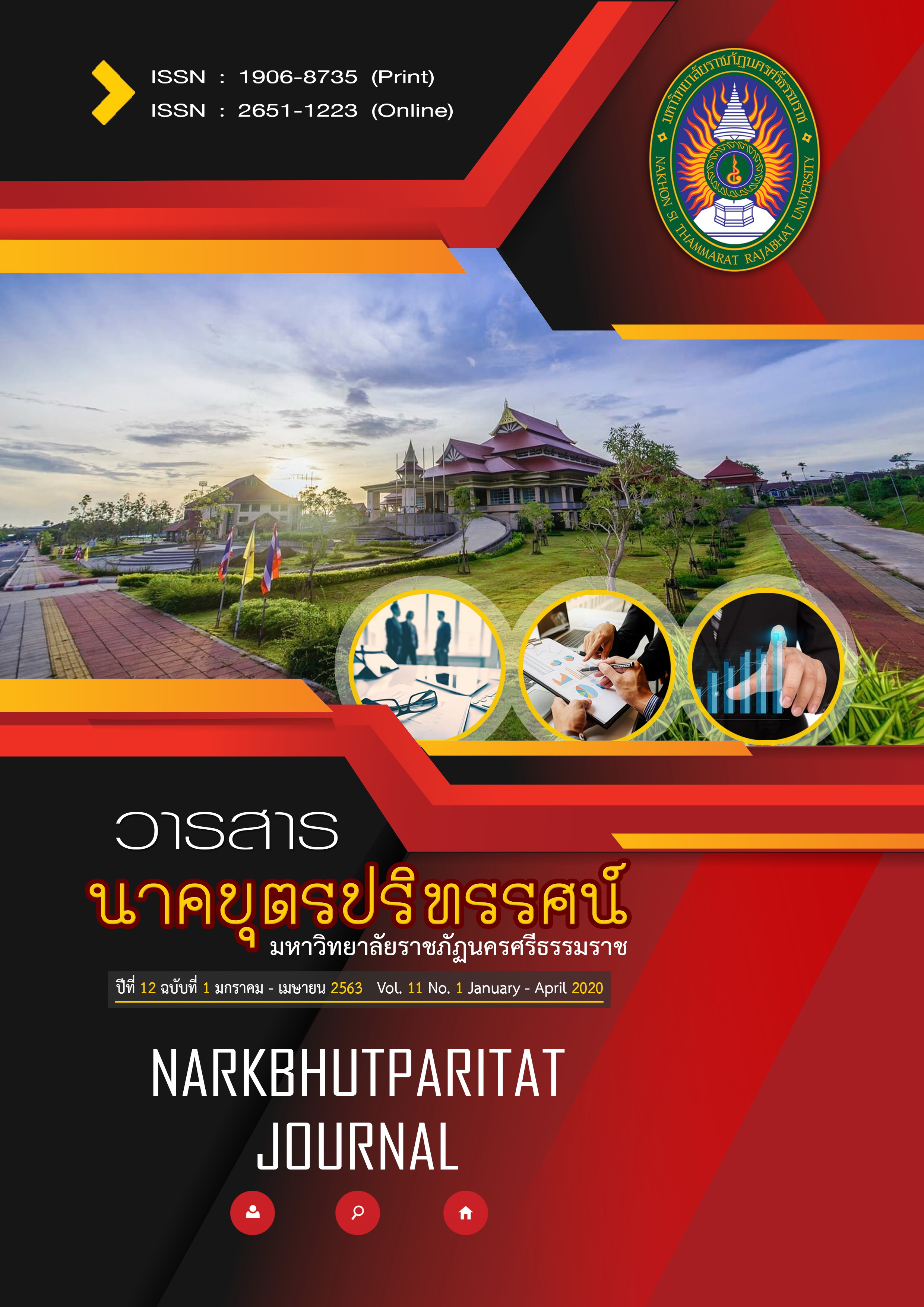ความสัมพันธ์ระหว่างปัจจัยเชิงสาเหตุและผลลัพธ์ของความผูกพันต่อองค์การที่ส่งผลต่อผลการปฏิบัติงาน Relationship between antecedents and consequences of organizational commitment affected employee performance
Main Article Content
Abstract
The purposes of this study were to determine relationship model between antecedents and consequences of organizational commitment that affected employee performance. Causal factors, for example, perceived organizational support, friendly environment and work-life balance, can affect workers’ performances. There is an organizational commitment as a moderator variable. Hence, the relationship model of any variables has been developed via review of literature, concept and related research. The results of this research can be applied in other studies in the future.
Article Details
Section
บทความวิจัย
References
Abdullah el al. (2012). Antecedents of organizational commitment of banking sector employees in Pakistan .Serbian. Journal of Management, 7(1), 89–102.
Abdullah et al. (2012) .The Relationship between Organizational Culture and Product Innovativeness. Procedia - Social and Behavioral Sciences, 129, 140-147
A.Gokul and G.Sridevi. (2012). The Relationship between Perceived Organization Support, Work Engagement and Affective Commitment. AMET International Journal of Management. July–Dec 2012.
Bernd Carette et al. (2013). Does career timing of challenging job assignment influence the relationship with in role job performance. Journal of Vocational Behavior. 83(1), 61–67.
Bhatnagar, J. (2007). Talent management strategy of employee engagement in Indian. ITES employees: Key to Retention. Employee Relations, 29(6), 640-663.
Buchanan, B. (1974). Building Organizational Commitment: The Socialization of Managersin Work Organizations. Administrative Science Quarterly, 19, 535-546.
Carter, T. and Cater, B. (2010). Product and relationship quality influence on customer commitment and loyalty in B2B manufacturing relationships. Industrial Marketing Management, 39, 1321-1333.
Donna I. Pickering. (2006). The relationship between work-life conflict/work-life balance and operational effectiveness in the Canadian Forces. Defence R&D Canada – Toronto Technical Report DRDC Toronto. December 2006. 2006-243
Donna M. Randall. (1997). Affective Versus Calculative Commitment: Human Resource Implications. Journal of Social Psychology - J SOC PSYCHOL, 137(5), 606-617.
Eisenberger et al. (1986). Perceived Organizational Support. Journal of Applied Psychology, 71(3), 500-507.
Emin Kahya. (2007). The effects of job characteristics and working conditions on job performance. International Journal of Industrial Ergonomics, 37(6), 515–523.
George, J. M. and Jones, G. R. (2002). Understanding and managing organizational behavior. N.J.: Prentice Hall.
Gilbreath, B., and Benson, P. G. (2004). The contribution of supervisor behaviour to employee psychological well-being. Work & Stress, 18 (3), 255-266.
Halbesleben and Wheeler. (2007). The Costs and Benefits of Working with those you Love: A Demand/Resource Perspective on Working with Family. Occupational Stress and Well-being, 6, 115–163.
Hye Kyoung Kim. (2014). Work-Life Balance and Employees' Performance: The Mediating Role of Affective Commitment. Global Business and Management Research: An International Journal, 6 (1).
Jamal, (2007). Burnout and self-employment: a cross-cultural empirical study. Stress and Health. 23, 249-256
Meyer, Allen and Smith. (1993). Commitment to Organizations and Occupations: Extension and Test of a Three-Component Conceptualization. Journal of Vocational Behavior,78 (4).
Prebbie and Wagstaff. (2005). Work Life Balance : a resource for the state services. New Zealand: State service Commission
Rhoades et al. (2001). Affective Commitment to the Organization: The Contribution of Perceived Organizational Support. Journal of Applied Psychology, 86(5), 825-836
Rhoades, L. and Eisenberger, R. (2002). Perceived organizational support: A review of the literature. Journal of Applied Psychology, 87(4), 698-714.
Robbins, S. P. and Judge, T. (2010). Essentials of Organizational Behavior. (10th ed.). New Jersey: Pearson/Prentice Hall.
Abdullah et al. (2012) .The Relationship between Organizational Culture and Product Innovativeness. Procedia - Social and Behavioral Sciences, 129, 140-147
A.Gokul and G.Sridevi. (2012). The Relationship between Perceived Organization Support, Work Engagement and Affective Commitment. AMET International Journal of Management. July–Dec 2012.
Bernd Carette et al. (2013). Does career timing of challenging job assignment influence the relationship with in role job performance. Journal of Vocational Behavior. 83(1), 61–67.
Bhatnagar, J. (2007). Talent management strategy of employee engagement in Indian. ITES employees: Key to Retention. Employee Relations, 29(6), 640-663.
Buchanan, B. (1974). Building Organizational Commitment: The Socialization of Managersin Work Organizations. Administrative Science Quarterly, 19, 535-546.
Carter, T. and Cater, B. (2010). Product and relationship quality influence on customer commitment and loyalty in B2B manufacturing relationships. Industrial Marketing Management, 39, 1321-1333.
Donna I. Pickering. (2006). The relationship between work-life conflict/work-life balance and operational effectiveness in the Canadian Forces. Defence R&D Canada – Toronto Technical Report DRDC Toronto. December 2006. 2006-243
Donna M. Randall. (1997). Affective Versus Calculative Commitment: Human Resource Implications. Journal of Social Psychology - J SOC PSYCHOL, 137(5), 606-617.
Eisenberger et al. (1986). Perceived Organizational Support. Journal of Applied Psychology, 71(3), 500-507.
Emin Kahya. (2007). The effects of job characteristics and working conditions on job performance. International Journal of Industrial Ergonomics, 37(6), 515–523.
George, J. M. and Jones, G. R. (2002). Understanding and managing organizational behavior. N.J.: Prentice Hall.
Gilbreath, B., and Benson, P. G. (2004). The contribution of supervisor behaviour to employee psychological well-being. Work & Stress, 18 (3), 255-266.
Halbesleben and Wheeler. (2007). The Costs and Benefits of Working with those you Love: A Demand/Resource Perspective on Working with Family. Occupational Stress and Well-being, 6, 115–163.
Hye Kyoung Kim. (2014). Work-Life Balance and Employees' Performance: The Mediating Role of Affective Commitment. Global Business and Management Research: An International Journal, 6 (1).
Jamal, (2007). Burnout and self-employment: a cross-cultural empirical study. Stress and Health. 23, 249-256
Meyer, Allen and Smith. (1993). Commitment to Organizations and Occupations: Extension and Test of a Three-Component Conceptualization. Journal of Vocational Behavior,78 (4).
Prebbie and Wagstaff. (2005). Work Life Balance : a resource for the state services. New Zealand: State service Commission
Rhoades et al. (2001). Affective Commitment to the Organization: The Contribution of Perceived Organizational Support. Journal of Applied Psychology, 86(5), 825-836
Rhoades, L. and Eisenberger, R. (2002). Perceived organizational support: A review of the literature. Journal of Applied Psychology, 87(4), 698-714.
Robbins, S. P. and Judge, T. (2010). Essentials of Organizational Behavior. (10th ed.). New Jersey: Pearson/Prentice Hall.


